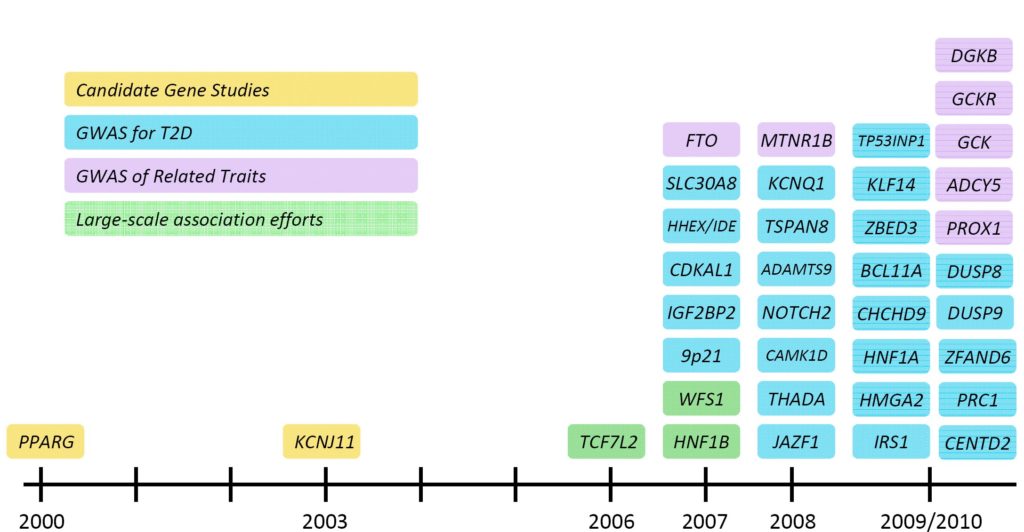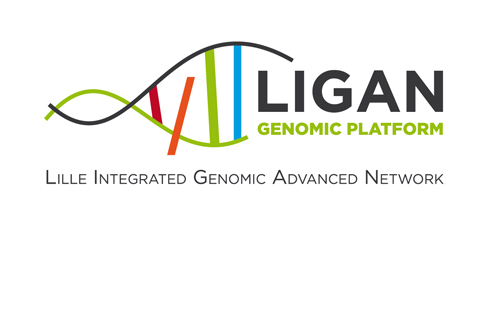Contact : Philippe Froguel (PUPH, CHU Lille)
Type 2 diabetes (T2D) is the most common form of diabetes (~90%). The pathogenesis of T2D is characterized by two major features: peripheral insulin resistance and impaired insulin secretion from pancreatic beta-cells. Westernization may largely explain the progressive increase in the prevalence of type 2 diabetes in the early part of the 20th century, particularly in developing countries. The cause of T2D is multifactorial. Reduced bêta-cell compensation to the insulin resistance associated with sedentary lifestyle and central obesity can gradually lead to T2D. However, the risk to develop the disease is very different between individuals of the same ethnic group living in the same environment. It has been estimated that 70% of T2D risk is explained by heritable factors. Since 2007, genome-wide association studies have identified ~50 loci for the most part associated with bêta-cell defect.
We know now that these genetic markers explain ~10% of T2D heritability. Even if it is still necessary to identify the etiologic variants, additional genetic and epigenetic factors may help understandig the missing heritability. In the next years, the clinical potential of these discoveries may lead to the development of personalized medicine (risk prediction of future T2D and utility in guiding pharmacotherapy)
Collaborations :
• Dr. Guillaume Charpentier, Centre Hospitalier Sud Francilien, Service d’Endocrinologie-Diabétologie, 116, Boulevard Jean Jaurès, Corbeil-Essonnes, France
• Pr. François Pattou, INSERM UMR859, Université de Lille – Droit et Santé, place de Verdun, Lille, France
• Pr. Bart Staëls, INSERM UMR1011, Institut Pasteur de Lille, 1 rue du professeur Calmette, Lille, France
• DESIR (Data from an Epidemiological Study on the Insulin Resistance Syndrome) Study Group
• DIAGRAM (Diabetes Genetics Replication And Meta-analysis) Consortium
Recent publications:
Perry JR, Voight BF, Yengo L, Amin N, Dupuis J, Ganser M, Grallert H, Navarro P, Li M, Qi L, Steinthorsdottir V, Scott RA, Almgren P, Arking DE, Aulchenko Y, Balkau B, Benediktsson R, Bergman RN, Boerwinkle E, Bonnycastle L, Burtt NP, Campbell H, Charpentier G, Collins FS, Gieger C, Green T, Hadjadj S, Hattersley AT, Herder C, Hofman A, Johnson AD, Kottgen A, Kraft P, Labrune Y, Langenberg C, Manning AK, Mohlke KL, Morris AP, Oostra B, Pankow J, Petersen AK, Pramstaller PP, Prokopenko I, Rathmann W, Rayner W, Roden M, Rudan I, Rybin D, Scott LJ, Sigurdsson G, Sladek R, Thorleifsson G, Thorsteinsdottir U, Tuomilehto J, Uitterlinden AG, Vivequin S, Weedon MN, Wright AF; MAGIC; DIAGRAM Consortium; GIANT Consortium, Hu FB, Illig T, Kao L, Meigs JB, Wilson JF, Stefansson K, van Duijn C, Altschuler D, Morris AD, Boehnke M, McCarthy MI, Froguel P, Palmer CN, Wareham NJ, Groop L, Frayling TM, Cauchi S.
PLoS Genet. 2012 May;8(5):e1002741.
• Low-frequency variants in HMGA1 are not associated with type 2 diabetes risk.
Marquez M, Huyvaert M, Perry JR, Pearson RD, Falchi M, Morris AP, Vivequin S, Lobbens S, Yengo L, Gaget S, Pattou F, Poulain-Godefroy O, Charpentier G, Carlsson LM, Jacobson P, Sjöström L, Lantieri O, Heude B, Walley A, Balkau B, Marre M, Froguel P, Cauchi S; DIAGRAM Consortium.
Diabetes. 2012 Feb;61(2):524-30.
Cauchi S, Rung J, Albrechtsen A, Shen L, Rocheleau G, Cavalcanti-Proença C, Bacot F, Balkau B, Belisle A, Borch-Johnsen K, Charpentier G, Dina C, Durand E, Elliott P, Hadjadj S, Järvelin MR, Laitinen J, Lauritzen T, Marre M, Mazur A, Meyre D, Montpetit A, Pisinger C, Posner B, Poulsen P, Pouta A, Prentki M, Ribel-Madsen R, Ruokonen A, Sandbaek A, Serre D, Tichet J, Vaxillaire M, Wojtaszewski JF, Vaag A, Hansen T, Polychronakos C, Pedersen O, Froguel P, Sladek R.
Nat Genet. 2009 Oct;41(10):1110-5.



